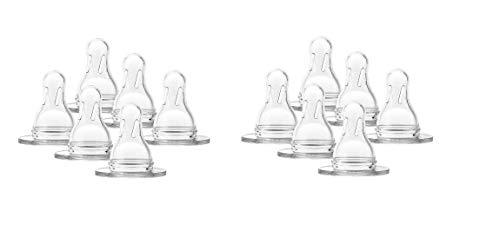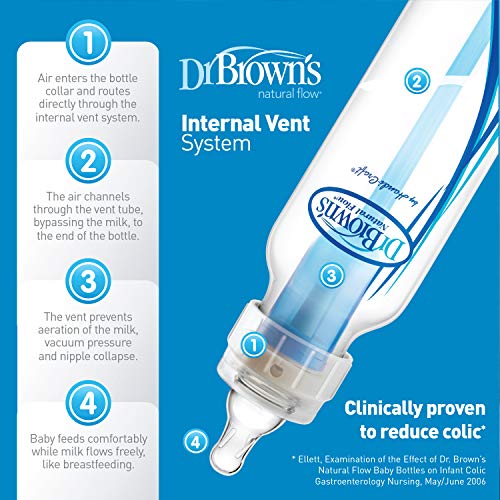Are you one of those parents asking why Dr.Brown’s bottles leak and how you can fix this problem? Is your kitchen cupboard full of feeding bottles for your baby? If you’re anything like other parents, you’ve tried a range of feeding bottle brands. Some you like, others you don’t. Your baby loves Dr. Brown’s bottles but there’s a problem sometimes.
It’s not unusual to have leaking problems with feeding bottles and there are solutions if you know what to look out for. The venting system of Dr. Brown’s bottles is often the culprit for why you’re having a leaky bottle. Getting the right nipples is also important and how you prepare the bottle for feeding.
I know it’s not easy to switch your baby to another bottle brand when they fall in love with Dr. Brown’s! This is why I did some extensive research on why Dr. Brown’s bottles sometimes leak. I’ve discovered ways to fix the leaky bottle problem!
In this article I talk about the innovative venting system of these feeding bottles if other bottle brands also leak, and what you need to know about different nipples.
Why Do Dr. Brown’s Bottles Leak?
The venting system design of these bottles may result in leaking problems if it’s not handled correctly. The system is made up of three parts namely the vent, the nipple, and the collar. Once inserted into the bottle, the bottle is no longer a fully sealed container.

Leaking problems may occur when you’re using the wrong nipple type, incorrect preparation of the bottle, or not storing the bottle properly.
Do All Baby Bottles Leak?
It’s not only Dr. Brown’s bottles that leak. Baby bottle manufacturers are always looking for ways to improve your baby’s feeding experience. This entails coming up with new designs all the time. Some designs may be leak-proof but most times, there will be a leaking problem if the bottle is not handled according to the manufacturer’s instructions.
The most common reason for most bottles leaking is the nipple flow level. Other problems could be the type of lid being used, the seal of the collar, the different venting system designs, and incorrect cleaning of the various parts of the bottle.
So, before you think about giving up on your baby’s favorite Dr. Brown’s bottle for another brand, consider finding a solution to the leaks.
How Does the Vent System Work in Dr. Brown’s Bottles?
The innovative internal venting system used in these bottles has been designed to prevent air from coming into contact with the formula. By channeling the air away from the liquids in the bottle, the vent system prevents the build-up of pressure in the bottle. It also eliminates any air bubbles forming in the liquid.
By minimizing negative pressure and build-up of air in the bottle, your baby is less likely to suffer from spit-ups, burping, gas, and colic.
Another bonus of keeping the air away from the milk is better preservation of the nutrients in the milk. So, your baby is getting all the essential nutrients they need during feeding.
Watch this video showing how the vent system works and the benefits of this system.
Do Dr. Brown’s Bottles Leak Without the Vent System?
The bonus of using Dr. Brown’s bottles is that you can choose between using the venting system or not. Of course, this defeats the object of using a vent system if you’re trying to stop colic and gas problems during feeding. But, colic often disappears once your baby is older. This means you can stop using the vent in the bottle.
But does this solve the leaking problem? It depends on what was causing the leaks in the first place. If the main problem was incorrect nipple flow levels, then you’ll still find Dr. Brown’s bottles will leak.
What Do I Need to Know About Dr. Brown’s Nipples?
Most bottle nipples are designed for the baby’s age group. However, Dr. Brown’s nipples have been designed to accommodate the baby’s particular feeding style. The most common type of nipple used with these bottles is Dr. Brown’s Natural Flow Level 1 Standard Nipple. This is often the best one to use for newborns as it’s designed for a slower flow of milk during feeding.

The different nipple levels allow you to adjust according to how your baby’s feeding development. Some babies prefer a faster flow of milk while others need a slower flow of milk. Older babies are often suited to a faster flow as their feeding develops. How do you know when the milk flow is too slow or too fast?
When the milk flow is too slow you’ll notice your baby is:
- Taking too long to finish a bottle
- Getting irritated or frustrated during feeding
- Starting to fuss and get restless during feeding
- Falling asleep before finishing their bottle
On the other hand, if the milk flow is too fast, your baby will:
- Start to choke or cough while feeding
- Be gulping their milk down
- Battle to swallow properly
- Refuse to take the bottle during feeding
Another sign of the milk flowing too fast is when it starts to leak from the bottle during feeding.
How to Fix Dr. Brown’s Bottles to Stop Them Leaking
Most parents report leaking problems during feeding, preparation, traveling, and when using the internal venting system.
How to Stop Dr. Brown’s Bottles From Leaking While Feeding
If you’re using the venting system, you must remember the bottle is no longer a fully sealed container. Ensure you hold the bottle at the right angle during feeding to minimize any risk of milk flowing out of the bottle.

Another reason for leaking during feeding could be the type of nipple you’re using. The level determines the flow of milk and if it’s too fast for your baby, you could end up with messy leaks during feeding.
Dr. Brown’s nipple levels are as follows:
- Preemie Nipple 0+ months: For premature babies and other babies who prefer a slower feeding flow.
- Level 1: This is ideal for babies from newborn to older and is for slow flow feeding.
- Level 2: Designed for babies from 3 months old who are drinking thicker milk formulas
- Level 3: Works well for babies from 6 months old, who are sitting up, and accepting solid foods as well.
- Level 4: From 9 months old, your baby is developing and has a consistent feeding pattern.
- Y-cut nipple: Works well for babies from 9 months old who are drinking thick milk formulas and cereals.
If you’ve been using Dr. Brown’s venting system for a long time, then the parts may become worn down from regular wear and tear. This could be the main reason for leaking problems during feeding so consider replacing the venting system.
Both Dr. Brown’s Options + Baby Bottle Replacement Kit and Dr. Brown’s Standard 8 oz. Bottle Replacement Vent Kit Natural Flow is available for solving this kind of problem.
 No products found.
No products found.
What to Do With Dr. Brown’s Bottles Leaking in the Diaper Bag
One of the most common problems with leaking is when the bottle is not stored upright. The venting system (vent, nipple, and collar) doesn’t offer a complete seal so it’s essential the full bottle is stored correctly in the diaper bag.
If the bottle is falling or tilting over, you’re likely to have a problem with leaks as the milk gets into the vent system. The best solution is to ensure the bottle is placed upright in a tight pocket in the diaper bag.
The other solution is to place a traveling disc under the nipple. This is always included when you buy one of Dr. Brown’s bottles. The other option is to buy a travel cap which is discussed in the next section.
How Can I Stop my Dr. Brown’s Bottles From Leaking While Traveling?
When the venting system is inserted, the bottle is going to leak if it’s not upright. Once the internal venting system is used, the bottle becomes an open system and liquid is going to leak via the nipple if the bottle lies flat.
If you’re traveling with the vent system in place then always make sure the bottle is stored upright in the diaper bag. Make sure the traveling disc is also inserted. Another option is to buy Dr. Brown’s Replacement Travel Caps. Make sure you buy the right size caps for the type of bottle you’re using.

These travel caps are your best solution for long-distance traveling. You’ll have to remove the venting system before screwing on the caps. These caps are also great for those times you want to store the formula in the bottle before use.
How to Stop Leaks From the Top or Neck of Dr. Brown’s Bottles
If the collar is not tightened enough on the bottle, you can expect the milk to leak from the top or neck of the bottle. But, if you over-tighten it, you’ll cause pressure to build up in the bottle. The milk will then flow into the vent system and leak.
Another reason could be using the wrong replacement parts for the bottle. If your bottle has a wide-neck then make sure you get Dr. Brown’s Options + Wide-Neck Replacement Kit designed for the wide-neck bottles. If you’re confused about this design, here’s my article on wide-neck vs narrow-neck bottles.
Overfilling the bottle could also lead to leaking problems. Make sure you only fill up to the maximum level of the bottle size (either 4 ounces or 8 ounces). It’s a good idea to add the formula first before filling it up with water to ensure you don’t overfill.
Why Do My Dr. Brown’s Bottles Leak During Preparation
If you shake the bottle while the formula and venting system is in the bottle, you could cause a build-up of pressure to take place. This will lead to leaking out of the collar. The same pressure build-up can happen when you’re warming up the bottle.
The best solution is to remove all the parts during preparation and screw on a travel or storage cap (mentioned above). If you don’t have these caps on hand, then loosen the cap during warming to relieve the pressure.
Final Thoughts
Dr. Brown’s bottles are popular with many parents who have babies suffering from colic and gas. The innovative venting system of these bottles ensures your baby is comfortable during and after feeding. However, it can lead to leaking problems if you don’t take into consideration some of the suggestions I’ve mentioned in my article.
Avoid having to toss out your Dr. Brown’s bottles because of leaking problems that can be fixed simply with these solutions. And ff you’re interested about learning on the differences between normal and anti-colic bottles, I wrote a separate aritcle on that.
Last update on 2024-03-29 / Affiliate links / Images from Amazon Product Advertising API

Never never never never put formula in bottle first before water. It messes up the ratio and can cause serious problems! Otherwise, good advice.